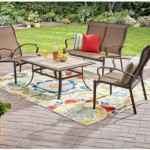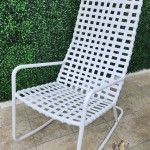What is the Standard Patio Umbrella Size?
Determining the "standard" patio umbrella size is not as straightforward as defining a single, universal measurement. The ideal size depends heavily on the dimensions of the patio, the furniture being shaded, and the desired level of coverage. Rather than a rigid standard, a range of sizes is commonly available, each suited for specific applications. This article will explore the common patio umbrella sizes, the factors influencing size selection, and important considerations for optimizing shade and functionality.
Patio umbrellas are essential for creating comfortable outdoor living spaces, providing protection from the sun's harmful UV rays and offering shelter from light rain. Selecting the appropriate size ensures that the umbrella effectively shades the intended area without being overwhelming or inadequate. Understanding the available size options is crucial for making an informed decision.
Common Patio Umbrella Sizes and Their Applications
While a single "standard" size is elusive, certain dimensions appear frequently in the market. These sizes cater to various patio arrangements, from small bistro sets to large dining tables and expansive lounge areas. Understanding the applications of each size helps narrow down the options for a given space.
7.5-Foot Patio Umbrellas: These are typically considered small to medium-sized umbrellas. They are well-suited for smaller patios, balconies, or intimate seating areas. Often paired with bistro sets consisting of two chairs and a small table, a 7.5-foot umbrella offers sufficient shade for a couple enjoying a meal or drinks. Their compact size makes them manageable and easy to move, a valuable feature for adaptable outdoor spaces.
9-Foot Patio Umbrellas: Representing a popular and versatile choice, the 9-foot umbrella is often cited as a common or "standard" size. This dimension offers a good balance between coverage and manageability. It's appropriate for shading four to six-person dining tables or small lounge areas. The 9-foot umbrella also works well with standard-sized patio tables featuring a center umbrella hole. Their widespread availability and adaptability make them a preferred option for many homeowners.
10-Foot and 11-Foot Patio Umbrellas: These larger umbrellas provide more substantial shade coverage, suitable for larger dining tables accommodating six to eight people or expansive outdoor seating arrangements. The extra diameter ensures that a greater portion of the patio is shielded from direct sunlight, enhancing comfort during peak sun hours. These larger sizes are often chosen for patios designed for entertaining or accommodating larger groups.
13-Foot and Larger Patio Umbrellas: These umbrellas are intended for commercial use or extremely large residential patios. They may take the form of cantilever or offset umbrellas, allowing for shade placement without a central pole obstructing the seating area. Due to their size and weight, these umbrellas often require substantial bases for stability and are typically not as easily moved. They are ideal for covering large outdoor dining areas, pool decks, or other expansive spaces.
It's important to note that these dimensions refer to the umbrella's canopy diameter. The actual shaded area can be influenced by factors such as the angle of the sun, the umbrella's tilt mechanism (if applicable), and the density of the canopy fabric.
Factors Influencing Patio Umbrella Size Selection
Choosing the right size patio umbrella involves considering several key factors related to the patio's layout, furniture dimensions, and the desired level of shade. Avoiding a "one-size-fits-all" approach is crucial for achieving optimal comfort and functionality.
Patio Dimensions and Shape: The overall size and shape of the patio are paramount. A small, square patio will require a smaller umbrella than a large, rectangular one. Consider the usable space and the placement of furniture when determining the appropriate umbrella diameter. An umbrella that is too large can make the area feel cramped, while one that is too small will not provide adequate shade. The shape of the patio can also influence the choice. For example, a long, narrow patio might benefit from a rectangular umbrella rather than a circular one.
Furniture Dimensions and Arrangement: The size and configuration of the patio furniture are critical considerations. Measure the diameter of the table or the area encompassed by the seating arrangement. Ideally, the umbrella's canopy should extend at least two feet beyond the edges of the furniture on all sides. This ensures that individuals seated around the table or lounging in the area are adequately protected from the sun throughout the day as the sun's angle changes.
Desired Shade Coverage: The desired level of shade is a subjective factor. Some individuals prefer full shade, while others prefer a dappled or partial shade. Consider the typical time of day when the patio is used most frequently. If the patio is primarily used during midday, when the sun is at its peak, a larger umbrella with a dense canopy will be necessary. If the patio is primarily used during the morning or evening, when the sun's angle is lower, a smaller umbrella may suffice. The canopy fabric's color and density will also impact the amount of shade provided. Darker fabrics typically offer more shade than lighter ones.
Umbrella Placement: The location where the umbrella will be placed influences size selection. For example, an umbrella placed through the center hole of a patio table requires a different sizing consideration than a cantilever umbrella positioned to the side of a seating area. In-table umbrellas are often chosen to match the table's diameter or slightly exceed it, whereas cantilever umbrellas need to be sized according to the entire area intended for shade, regardless of furniture arrangement directly underneath.
Important Considerations for Optimizing Shade and Functionality
Beyond selecting the appropriate size, several other factors contribute to maximizing the effectiveness and longevity of a patio umbrella. Paying attention to these details enhances the overall outdoor experience.
Umbrella Base Weight and Stability: A stable umbrella base is essential for preventing the umbrella from tipping over in windy conditions. The weight of the base should be proportionate to the size of the umbrella. Generally, larger umbrellas require heavier bases. The manufacturer's recommendations regarding base weight should always be followed. Insufficient base weight poses a safety hazard and can lead to damage to the umbrella and surrounding property. Some bases can be filled with sand or water to increase their weight.
Canopy Fabric and UV Protection: The canopy fabric should be durable, weather-resistant, and offer adequate UV protection. Fabrics such as solution-dyed acrylic are known for their colorfastness, resistance to fading, and ability to block harmful UV rays. Polyester fabrics are a more affordable option but may not be as durable or offer the same level of UV protection. Look for fabrics with a UPF (Ultraviolet Protection Factor) rating to ensure adequate sun protection. Regular cleaning and maintenance of the canopy fabric will extend its lifespan.
Tilt and Crank Mechanisms: Many patio umbrellas feature tilt and crank mechanisms that allow for adjusting the angle of the canopy and opening or closing the umbrella with ease. A tilt mechanism allows for adjusting the umbrella's angle to block the sun as it moves across the sky, maximizing shade coverage throughout the day. A crank mechanism makes it easier to open and close the umbrella, especially larger models. These features enhance the user experience and make the umbrella more convenient to use.
Wind Resistance and Durability: Patio umbrellas are subjected to wind, rain, and sun exposure. Selecting a model with robust construction and wind-resistant features is crucial for ensuring longevity. Look for umbrellas with reinforced ribs, durable frames, and wind vents that allow air to pass through the canopy, reducing the risk of the umbrella being blown over or damaged in gusty conditions. Regular maintenance and proper storage during the off-season will further extend the umbrella's lifespan.
Storage and Maintenance: Proper storage and maintenance are essential for preserving the condition of the patio umbrella. When not in use, the umbrella should be closed and secured with a tie or strap. During the off-season, the umbrella should be stored in a dry, protected area to prevent damage from moisture, mold, or mildew. Regularly clean the canopy fabric with mild soap and water to remove dirt and debris. Inspect the frame and ribs for any signs of damage and make necessary repairs promptly. Following these simple maintenance practices will help extend the life of the patio umbrella and ensure its continued functionality.
Ultimately, determining the "standard" patio umbrella size means understanding the common sizes available, evaluating the specific needs of the patio space, and considering factors such as furniture dimensions, desired shade coverage, and wind resistance. Careful planning and attention to detail will result in selecting an umbrella that enhances the outdoor living experience for years to come.

Patio Umbrella Size Guide Midtownumbrellas Com

Patio Umbrella Size Guide Midtownumbrellas Com

The Ultimate Patio Umbrella Buyers Guide

Patio Umbrella Guide Buy With Confidence Now

Umbrella Measurement Choose The Right Sizes

Patio Umbrella Size Guide Midtownumbrellas Com

Umbrella Measurement Choose The Right Sizes

Patio Umbrella Guide Buy With Confidence Now

Smile Mart 9ft Standard Patio Umbrella With Led Lights Dark Green Com

Umbrella Measurement Choose The Right Sizes
See Also








